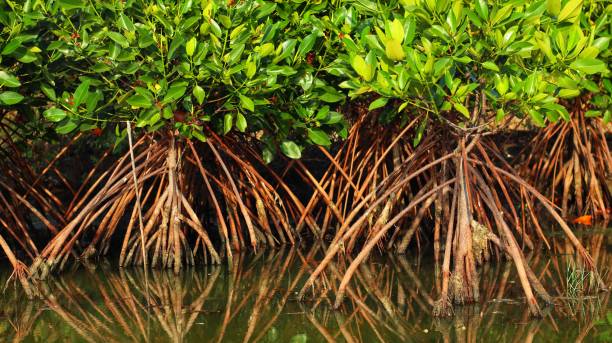Maharashtra, a coastal gem of western India, boasts over 720 km of shoreline and some of the country’s richest mangrove ecosystems. These unique forests thrive where land meets sea, forming a vital green shield for the coastline. Maharashtra’s mangroves are not just natural wonders; they’re ecological warriors—protecting against erosion, nurturing biodiversity, and supporting livelihoods.
Yet, as urbanization, industrialization, and climate change gather speed, these coastal sentinels are under threat. Their preservation isn’t just an environmental need—it’s an economic, climatic, and social imperative.
🌿 What Are Mangroves and Why Are They Important?
Mangroves are salt-tolerant trees and shrubs found in tropical and subtropical tidal zones. Maharashtra’s mangroves, spread across Mumbai, Thane, Raigad, Ratnagiri, and Sindhudurg, form dense root networks that:
- Protect shorelines from cyclones, tsunamis, and rising tides.
- Act as carbon sinks, storing up to 10x more carbon than terrestrial forests.
- Provide critical habitats for fish, crabs, migratory birds, and endangered species.
- Support local communities through fisheries, eco-tourism, and sustainable harvesting of resources.
These forests act much like urban forests in cities—offering cooling effects, pollution absorption, and biodiversity—but they do it in the harshest coastal conditions. Read more about the benefits of urban forests in India and how green cover in cities transforms lives.
🚨 The Threats Facing Maharashtra’s Mangroves
Despite their importance, Maharashtra’s mangroves face mounting challenges:
1. Urban Encroachment
Mega-cities like Mumbai have expanded rapidly, leading to illegal land reclamation and destruction of mangrove zones. Between 1991 and 2018, Mumbai alone lost over 40% of its mangrove cover.
2. Pollution
Dumping of untreated sewage, plastics, and industrial waste degrades mangrove soils and waterways, suffocating root systems and reducing fish populations.
3. Climate Change
Rising sea levels and erratic rainfall patterns impact the salinity and structure of these ecosystems.
4. Unsustainable Practices
Overharvesting for fuel, construction, and fishing bait weakens regeneration capacity.
Just as we rely on lake restoration in India to replenish urban water bodies, a similar focused approach is needed to revive our coastal wetlands.
🌱 Conservation Efforts and Community Involvement
Fortunately, conservationists, government bodies, and local communities are rallying to protect Maharashtra’s mangroves.
🔹 Mangrove Cell – Maharashtra Government
This specialized department oversees protection, afforestation, and awareness programs. In Mumbai, the Mangrove Cell has developed 10 mangrove parks and eco-tourism zones.
Explore the official resource here:
🔗 Mangroves in Maharashtra
🔹 Mangrove Protection App
The Mangrove Suraksha App allows citizens to report illegal activities, enabling better enforcement through public participation.
🔹 Community-Driven Restoration
Villages like Navghar in Palghar district have embraced community mangrove nurseries—a model similar to rural tree plantation programs that empower locals to restore degraded lands.
🏝️ Mangroves and Coastal Forests: A Natural Alliance
Maharashtra’s coastline benefits from the synergy of mangroves and beach forests. These forest types complement each other in:
- Shoreline stabilization
- Storm buffering
- Biodiversity support
Conservation efforts often involve both mangrove afforestation and beach cleaning initiatives to remove plastic, glass, and oil spills. Together, these actions restore the beauty and functionality of coastal ecosystems.
🍃 Agroforestry and Mangroves: A Resilient Coastal Strategy
In regions adjoining mangrove belts, integrating agroforestry practices helps prevent further land degradation. Agroforestry buffers the impact of salinity, reduces soil erosion, and provides sustainable incomes from crops, timber, and honey—without cutting into mangrove zones.
This complementary land-use system ensures that both agriculture and conservation can coexist, strengthening community resilience.
🌾 Food Forests Near Coastal Zones
Some coastal villages have begun experimenting with food forests—layered systems of fruit trees, herbs, and shrubs modeled after natural forests. These can be developed adjacent to mangrove plantations, serving dual purposes:
- Providing food security and nutritional diversity
- Reducing pressure on mangrove forests for fuel and food
- Supporting pollinators and wildlife
In synergy with mangroves, food forests offer climate-resilient solutions for both conservation and community wellbeing.
📈 Current Status of Maharashtra’s Mangroves
As per the Forest Survey of India 2021, Maharashtra ranks second in India for mangrove cover (around 324 sq. km), just behind West Bengal. Although there’s been a net gain in cover due to reforestation, illegal encroachments and industrial activities continue to pose threats.
Government targets include afforesting an additional 10,000 hectares of degraded coastal land with mangroves by 2030 under the state’s Climate Action Plan.
❓ FAQs About Maharashtra’s Mangroves
Q1: Where are the major mangrove belts in Maharashtra?
Key locations include:
- Mumbai (Gorai, Versova, Airoli)
- Thane Creek
- Uran and Panvel (Raigad district)
- Ratnagiri and Sindhudurg
Q2: How do mangroves help in flood control?
Mangrove roots trap sediment and reduce wave energy, acting as natural levees that prevent inland flooding—especially during cyclones and heavy monsoons.
Q3: What are the economic benefits of mangroves?
Mangroves support fishing, honey production, eco-tourism, and even carbon trading, offering sustainable income streams for locals.
Q4: Can we replant mangroves anywhere along the coast?
No. Mangroves need specific tidal and salinity conditions. Restoration must involve native species and community input for success—similar to best practices in tree plantation programs.
Q5: How are mangroves linked to climate action?
They sequester large amounts of blue carbon and protect coastal infrastructure, aligning directly with India’s climate mitigation goals.
🔗 Internal Resources for Further Reading
Explore related initiatives helping protect India’s natural ecosystems:
- Mangroves in Maharashtra
- Agroforestry in India
- Urban Forests in India
- Tree Plantation in India
- Food Forests in India
- NGO for Beach Cleaning in India
- Lake Restoration in India
🌍 Conclusion: The Future of Maharashtra’s Coasts
Mangroves are not just trees—they are life-support systems. From fish nurseries to flood protection, they anchor the health and resilience of coastal Maharashtra.
To protect them, we need a collaborative approach: government policies, citizen participation, scientific expertise, and sustainable development models like agroforestry, urban forests, and food forests.
The lifeline of the coast is in our hands. Let’s nurture it.
